One of the garden bed methodologies we’ve learned about is hugelkultur. Generally, this involves burying (below and/or above ground) tree materials, like stumps, trunks or even branches, under your garden soil. Apparently, as the tree material rots, it also becomes very absorbent, and is supposed to help with holding moisture in the garden bed. There is lots of information and videos about it on the Internet, but here is our first attempt at doing one of these. Since we’re observing a land sabbath and aren’t growing gardens or crops this year, I definitely wanted to start on these while I had extra time.
I decided to just locate the beds as an extension of our main garden area, and here is the first level dug out. I thought using the dug-out dirt as a berm around the bed would help even make it deeper:
After the first digging, in looking at it, and I think even trying it out by putting a stump in place, it just wasn’t deep enough, so I dug out another round:
Then, it was time to gather the wood material. For this first bed, I thought I’d go with larger items, and so I went around trying to collect old stumps and similar things:
And here is the bed full. It was like a puzzle trying to place the pieces to fit as tightly as possible:
The plan was to then cover the bed with mulch. I had originally wanted to fill the entire thing with sifted mulch, but realized that was going to take a lot of effort for probably not much gain, since I could fill the bed up leaving 8-10 inches at the top with the wood-chips mulch we get from the landfill, and then sift from there, which is what I did. This is the mulch in place:
And then the sifting process. I used that long board across the bed for sliding the mulch sifter back and forth:
And here it is complete!
Lord willing, I hope to add another bed in front of this one.
Composting
We had recently discovered that the area all around our goat sheds, where we put the hay and goat “evacuations” cleaned out from the sheds, with rain water collecting there, and over time, was composting nicely into this fine, fluffy dirt. Some time ago, we were given a composting container; and so I figured, since this goat material seemed to compost well, it was time to get that process going; and here is the container set up, and then a look inside. The container has holes on the sides and the top and bottom pieces:
We thank the Lord for granting us the opportunity to continue on the process out here of trying to grow our own food, and for hopefully new and beneficial ideas; and we thank Him for the physical strength and materials to do these things.
— David
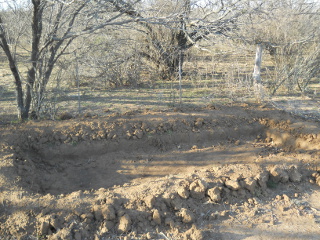
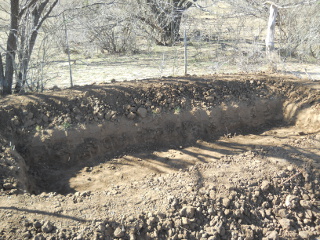
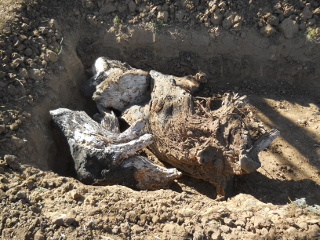
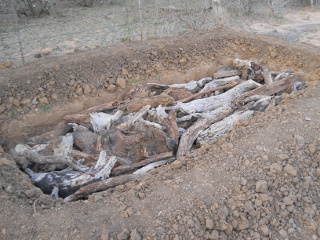
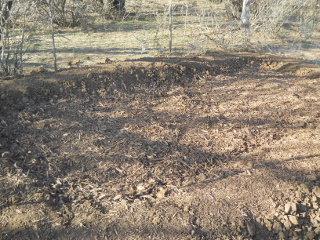
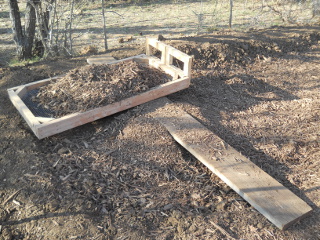
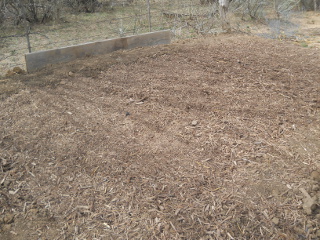
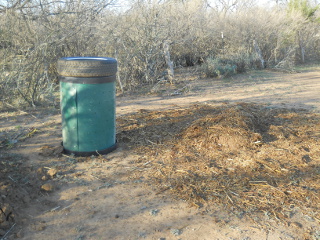
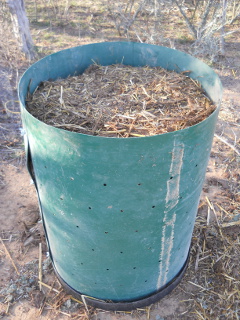
Interesting. All of the Hugelkulture Ive seen so far is above ground, though I realize most dig a bit first. Thanks
You might want to watch this. It is free to watch online (they do try to sell a dvd if you want) and his theories are quite similar. I could look at this guys garden all day long! http://backtoedenfilm.com/
Hi Adams Family,
Well, I just figured it was better to try to catch and then hold as much water in the first place with it being dug out…just seems like water on an all-above-ground bed would end up running off more. Those were my thoughts anyway.
Hi sally mae,
Actually, we've done quite a bit in that regard: http://blog.siffordsojournal.com/2012/03/not-too-mulch-of-good-thing.html. Thanks for mentioning it though.
And thank you both for saying hello.
— David
Oh I love it! Is his theory working well for you?
Hi sally mae,
Well, we put the "eden" beds in last year. I did try to grow some black-eyed peas in garden #1 the first (last) year, without really watering them too much…they sprouted, but nothing really became of them. And this year is our land sabbath, so we won't be really trying them out until next season, Lord willing.
— David
Hi David, I too am interested in how well this below ground approach works as all I have seen is the mound technique.
Chris
Liberty Hill, TX
Hello from Virginia, David and Susan!
I have been binge reading your blog for a few days now, and I have to tell you how wonderful I think you are and that you are an inspiration. I wanted to know how that Eden bed worked out? We moved away from "civilization" a few years ago and are struggling with our gardening. The soil here is red clay and rocks. I am planning on trying the straw bale method next spring. We might give the Hugel style a shot too, if it worked for you. I love the idea. Thanks for sharing your knowledge with us!!!!
Gracie Mae
Virginia
Hi Gracie Mae,
Welcome! We always pray the Lord glorify Himself through us out here, and that maybe He might benefit someone.
Yes, it's difficult, especially if you're just starting, or the land that is just starting, and we're still trying to find our way with these things too. 🙂 We have a lot of clay here also, and the red soil in places. And very intermittent rain, which the Eden beds have really helped with, in keeping in the moisture. And I can set a hose that runs by gravity from our cistern in the garden, and let it go for 10 or 15 minutes, and then just move it, which keeps me from having to manually water the whole time. The only thing with the Eden beds is to make sure you've started your plants in very good soil, either in containers before transplanting, or deeper in the Eden bed if good soil is there, or by putting some soil in the Eden bed in rows, or in spots where you put seeds. Hopefully over time as things compost, the lower soil layer will grow.
The hugelkultur bed is just ok so far. I've only filled it once with mulch, and it needs it another layer. Plus, apparently a true hugelkultur bed has everything above ground (vs. in a dug-out bed like I did) so less ground contacts and thereby absorbes water, taking it away from the bed soil itself.
Hope things go well for you, and thanks for saying hi!
— David